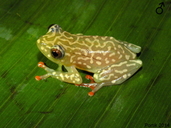|
Description
A Hyperolius from the highlands of western Cameroun and adjacent parts of Nigeria. Males are medium-sized (27–30 mm), females large (40 mm). Pupil horizontal. Phase J green with light canthal and dorsolateral stripes, phase F with a vermiculated pattern in yellow, red and black (ssp. riggenbachi) or yellow and black (ssp. hieroglyphicus). Colour in Phase J: Dorsum bright green with a narrow greenish-yellow canthal and dorsolateral stripe. Ventrum yellow, ventral surfaces of limbs greenish-yellow. Toes and fingers red. Phase F coloration: see under subspecies. A very few males show the phase F coloration.
This species can be divided into two distinct subspecies with strikingly different phase F colour pattern:
H. r. riggenbachi: Dorsum and dorsal surfaces of head and limbs with a complicated vermiculated pattern in black, red and yellow. Ventrum orange.
H. r. hieroglyphicus Ahl 1931: Dorsal surfaces vermiculated in bright yellow on a jet-black background, or vermiculated black on a yellow background. Ventrum bright orange to red. Underside of feet and hands bright red.
H. r. riggenbachi thus has three colours involved in the complicated pattern, H. r. hieroglyphicus only two.
A comparison shows, however, that the two patterns are closely related. If the red pigmentation of riggenbachi is substituted with black, the hieroglyphicus pattern will emerge. The phase J males of the two subspecies are identical.
The tadpole is a typical Hyperolius tadpole, the largest measured being 42 mm (17+25) with a tooth formula of 1/1+1,2.
Distribution and Habitat
Country distribution from AmphibiaWeb's database: Cameroon, Nigeria
Found in bushland localities in highlands above 900 m. There are, however, records by Perret of this species (under the name of H. benueensis Monard) from the savanna lowlands. Amiet is somewhat doubtful about this extension into the lowlands.
Distributed in Cameroun and easternmost Nigeria. Strangely enough, H. r. riggenbachi seems to be distributed in an enclave within the distribution area of H. r. hieroglyphicus.
Life History, Abundance, Activity, and Special Behaviors
The call has been recorded for H. r. hieroglyphicus; Amiet notes that the voice of H. r. riggenbachi is identical. It is a series of 5–12 clicks at a rate of about 15–20 per second, with an indistinct frequency-intensity maximum at about 3500–4000 cps.
Comments
This species shows developmental changes in patterning, with two phases, J (juveniles and many mature males) and F (mature females and some mature males). All newly metamorphosed individuals are phase J, which is normally brownish to green with paired light dorsolateral lines, or an hourglass pattern. All females, and some males, develop into phase F before the first breeding season. Phase F is often colorful and variable, showing the diagnostic color characteristics for the species or subspecies. Either well-defined morphs may be present, or graded variation.
This account was taken from "Treefrogs of Africa" by Arne Schiøtz with kind permission from Edition Chimaira publishers, Frankfurt am Main.
References
Schiøtz, A. (1999). Treefrogs of Africa. Edition Chimaira, Frankfurt am Main.
Originally submitted by: Arne Schiøtz (first posted 2001-01-10)
Edited by: Kellie Whittaker (2008-09-10)Species Account Citation: AmphibiaWeb 2008 Hyperolius riggenbachi: Riggenbach's Reed Frog <https://amphibiaweb.org/species/579> University of California, Berkeley, CA, USA. Accessed May 29, 2025.
Feedback or comments about this page.
Citation: AmphibiaWeb. 2025. <https://amphibiaweb.org> University of California, Berkeley, CA, USA. Accessed 29 May 2025.
AmphibiaWeb's policy on data use.
|




 Map of Life
Map of Life